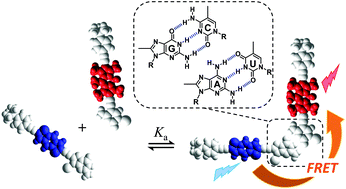Dye-conjugated complementary lipophilic nucleosides as useful probes to study association processes by fluorescence resonance energy transfer†
Abstract
Modern supramolecular chemistry relies on the combination of diverse analytical techniques that can provide complementary information on complex self-assembly landscapes. Among them, resonance energy transfer, monitored by fluorescence emission spectroscopy, arises as a sensitive and convenient phenomenon to report binding intermolecular interactions. The use of molecular probes labelled with suitable complementary energy-transfer pairs can provide valuable information about the thermodynamics, kinetics and self-sorting characteristics of a particular self-assembled system. The objective of this work is to generate a set of nucleoside FRET probes that can be reliably employed to prove and analyse quantitatively H-bonding interactions between complementary Watson–Crick pairs. We first describe the preparation of a set of lipophilic nucleosides that are linked to a π-conjugated functional fragment. The bases include guanosine and 2-aminoadenosine as purine heterocycles, and cytidine and uridine as complementary pyrimidine bases. The π-conjugated moiety comprises either a short phenylene-ethynylene oligomer, a bithiophene, or a BODIPY dye. We then demonstrate that the last two chromophores constitute an energy donor–acceptor couple and that donor emission quenching can be related to the ratio of molecules bound to the complementary acceptor pair. Hence, fluorescence spectroscopy in combination with resonance energy transfer, is shown here to be a useful tool to study and quantify the association and self-sorting events between complementary and non-complementary nucleosides in apolar aromatic solvents, where the binding strength is considerably high, and sensitive techniques that employ low concentrations are demanded.



 Please wait while we load your content...
Please wait while we load your content...